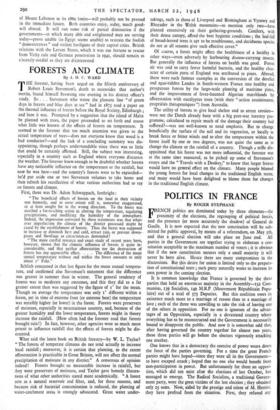FORESTS AND CLIMATE
By J. I). :. WARD
THE forester, having been urged on the fiftieth anniversary of Robert Louis Stevenson's death to reconsider that author's merits, found himself browsing one evening in his district officer's study. So . . . Stevenson who wrote the pleasant line " of green
days in forests and blue days at sea " had in 1873 read a paper on the thermal influence of forests before the Royal Society, Edinburgh ; and here it was. Prompted by a suggestion that the island of Malta be planted with trees, the paper proceeded to set forth and assess what little was known of the effects of forests on temperature. It seemed to the forester that too much attention was given to the actual temperature of trees—does not everyone know that wood is a bad conductor?—and the lack of a concluding summary was dis- appointing, though perhaps understandable since there was so little that could be certainly affirmed. Still, the subject was interesting, especially in a country such as England where everyone discusses the weather. The forester knew enough to be doubtful whether forests
have any noticeable influence on the temperature or the rainfall, but now he was here—and the country's forests were to be expanded—
he'd put aside one or two Stevenson volumes to take home and then refresh his recollection of what various authorities had to say on forests and climate.
First, there was Dr. Adam Schwappach, forthright:
" The beneficial effects of forests on the land in their vicinity was formerly, and to some extent still is, somewhat exaggerated, or at least sought for in the wrong direction. To the forest was ascribed a far-reaching action in altering the temperature, regulating precipitations, and modifying the humidity of the atmosphere. Indeed, he impression conveyed by these statements was that what: ever imperfection the climate of the district possessed might be cured by the establishment of forests. Thus the forest was supposed to increase or diminish hest and cold, attract rain, or prevent down- pours and floodings as circurastames demanded!
" The more careful research and exact study of recent years have, however, shown that the climatic influence of forests is quite in- considerable, and that neither afforestation nor the destruction of forests has any appreciable effect. . . . The difference of the mean annual temperature without and within the forest amounts to only about r° Fahr."
Schlich concurred in that last figure for the mean annual tempera-
ture, and confirmed also Stevenson's statement that the difference was greater in summer than in winter. The general tendency of forests was to moderate any extremes, and this they did to a far greater extent than was suggested by the figure of t° for the mean.
Though on average the temperature was only t° different within a forest, yet in time of extreme frost (or extreme heat) the temperature was sensibly higher (or lower) in the forest. Forests were preservers of moisture, especially in mountainous country, and, because of the greater humidity and the lower temperature, forests might in theory increase the rainfall. (How often had the forester read that forests brought rain!) In fact, however, other agencies were so much more potent to influence rainfall that the effects of forests might be dis- counted.
What said the latest book on British forestry—by W. L. Taylor? " The forests of temperate climates do not tend actually to increase local rainfall ; moreover, it is certain that planting, to the extent afforestation is practicable in Great Britain, will not affect the normal precipitation of moisture in any district." A consensus of opinion indeed! Forests brought no measurable increase in rainfall, but they were preservers of moisture, and Taylor gave homely illustra- tions of what other authorities stated more academically. " A forest acts as a natural reservoir and filter, and, for these reasons, and because risk of bacterial contamination is reduced, the planting of water-catchment areas is strongly advocated. Great water under- takings, such as those of Liverpool and Birmingham at Vyrnwy and Rhayader in the Welsh mountains—to mention only two—have planted extensively on their gathering-grounds. Conifers, with their dense canopy, afford the best hygienic conditions ; the leaf-fall of broad-leaved trees is apt to be troublesome, and deciduous species do not at all seasons give such effective cover."
Of course, a forest might affect the healthiness of a locality in other ways—even adversely by harbouring disease-carrying insects. But generally the influence of forests on health was good. Forest air was said to carry fewer harmful bacteria, and the healthy char- acter of certain parts of England was attributed to pines. Abroad, there were such famous examples as the conversion of the derelict and ague-ridden Landes in South-western France into healthy and prosperous forests by the large-scale planting of maritime pines, and the improvement of fever-haunted Algerian marshlands by afforestation with eucalyptus trees (with their " action assainissante, proprietes therapeutiques ") from Australia.
The utility of forests to give local shelter and to arrest erosion— were not the Dutch already busy with a big post-war forestry pro- gramme, calculated to repair much of the damage their country had suffered?—was too well-known to need emphasis. But to change beneficially the surface of the soil and its vegetation, or locally to break fierce or bitter winds and to alter the temperature within the forest itself by one or two degrees, was not quite the same as to change the climate or the rainfall of a country. Though a trifle dis- appointed that his forest was not more influential, the forester was at the same time reassured, as he picked up some of Stevenson's essays and the " Travels with a Donkey," to know that larger forests would have no general effect on the climate. Many people blamed the young forests for local changes in the traditional English scene, and many would have been delighted to blame them for changes in the traditional English climate.






























 Previous page
Previous page